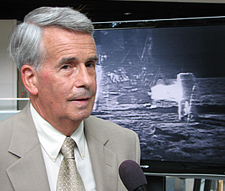NASA Abandons Apollo 11 Tape Search
NASA has finally thrown in the towel on its prospects for locating its missing Apollo 11 video recordings.
At a special press conference held in Washington, D.C. on the 40th anniversary of the Apollo 11 launch, NASA senior video engineer, Richard Nafzger said that the agency has already moved out in another direction─the restoration of the best surviving footage of the historic first footsteps on the moon by astronaut Neil Armstrong.
“The restoration is ongoing and may produce even better video,” Nafzger said. “We’re thrilled with the progress and with the restored video from the best source material obtained.”
NASA has contracted Lowry Digital, a content restoration firm located in Burbank, Calif. to clean up both film and videotape recordings made on the evening of from July 20, 1969.

The tapes that were the object of the massive search were not standard video recordings, but rather 1-inch instrumentation tape on which narrow band video shared space with mission telemetry and other information about the spacecraft and its crew. The 14-inch reels ran at 120 inches per second, with each holding about 15 minutes of data. Slow scan video from the camera on board the lunar lander occupied one of 14 tracks laid down on these tapes.
They were being sought, as even the reduced bandwidth video contained on them is believed to be significantly higher in quality that the surviving network television 2-inch video recordings.
Due to communication channel bandwidth limitations, standard 525-line/60-field NTSC video could not be relayed to earth from the moon. NASA had a special camera constructed that produced video that fit within the 500 KHz channel that was available. It produced 320 lines at 10 frames a second, non-interlaced.
In order to provide video to the estimated 600 million persons watching that evening, NASA also had special standards converters constructed for each of the tracking stations that would be in acquisition with the lunar lander. As electronic components weren’t nearly so sophisticated then, the converters relied on simple optical conversion─a standard NTSC television camera trained on the screen of a special slow-scan monitor being fed with the lowered line number and frame rate video.
While this simple conversion tactic worked, it was far from satisfactory. Contrast was blocked up and a large amount of noise and other distortion was added to the video. The overall effect could be described as rather “ghostly” or “ethereal,” especially when coupled to the unnatural presentation of motion caused by the reduced frame rate.
The NASA recordings captured these slow scan images in their native format and the agency had hopes that conversion to a standard video format with today’s processing technology would yield substantially better images of the historic arrival of man on the moon than previously available.
Nafzger explained that a great amount of effort had been expended in searching for the missing recordings, but it seems likely that don’t exist anymore.
“After an exhaustive search, we believe we know the fate of these messing telemetry tapes,” Nafzger said. “We think the tapes were degaussed, recertified and returned for use in the (NASA) network.
He said that thousands of tapes from the Apollo missions has been removed from the National Records Center and delivered to NASA’s Goddard facility for evaluation of data contained on them. They were never returned. The search centered on 45 of these tapes, containing a total of three hours of video from the moon.
“Our (search) team was very dedicated,” he said. “Thousands of people around the world were trying to help us. I just wish that someone had said that these tapes have got to be set aside. No one at NASA treated them any differently than any other tapes.”
Nafzger said that NASA decided to abandon the search and move on to restoration of the best surviving images possible. These included archived videotape from CBS, additional videotape recorded in Sydney, Australia, 16mm kinescope recordings made by NASA, and even 8mm home movie footage shot from a monitor screen at an Australian tracking site.
A “sneak peak” at the restored video was offered during the press conference, and revealed that even though the source material was not pristine, some improvement in detail was possible.
Nafzger also revealed evidence of some experimental 2-inch recordings of the 320/10 video were made at the Parkes, Australia tracking station, and that these may still survive. He said that machines were still available to play these tapes if they can be located.
Lowry Digital expects to complete the video restoration project by September.
The professional video industry's #1 source for news, trends and product and tech information. Sign up below.
